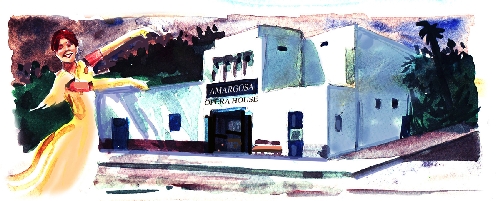80-something still packs Amargosa Opera House

The show goes on at the Amargosa Opera House in Death Valley Junction, Calif. Sunday matinee performances begin today at 2 p.m. and run through May 5.
The 2011-2012 schedule marks 45 seasons of live performances featuring Marta Becket, a multitalented veteran of ballet and theater. On Feb. 12, Becket hopes to begin “Life Is a Three Ring Circus,” a new show to celebrate her first performance at the Armagosa Opera House in 1968.
Because of an overworked knee, Becket now does sit-down shows featuring stories and characters from her creative past. Lively and entertaining in her late 80s, the performer still gives her audiences their money’s worth.
Reserve tickets for specific dates by calling the Amargosa Opera House and Hotel at (760) 852-4441 or visiting amargosa-opera-house.com. Tickets cost $15 for adults and $12 for children ages 5 to 12. Doors open for the Sunday matinees at 1:30 p.m.
The opera house anchors one end of a U-shaped adobe complex built by the Pacific Coast Borax Company from 1923 to 1926 near the tracks of the long-gone Tonopah & Tidewater Railroad. The complex contained offices, a store, a dining hall, an employee dormitory and a 23-room hotel. The opera house originally served as a community hall for the company town.
The single-story, Mexican Colonial-style structure sits at the junction of California Routes 127 and 190, the road to Furnace Creek in Death Valley. Today, a popular shortcut to Death Valley National Park also junctions there. From Las Vegas, drive 65 miles on Nevada Route 160 to Pahrump. Head north through town to Bell Vista Road. Follow this paved route about 30 miles to Death Valley Junction, passing the southern entrance to Ash Meadows National Wildlife Refuge.
When Marta Becket first saw the aging adobe complex in 1967, Death Valley Junction was a privately owned ghost town. While waiting for a flat tire to be fixed, she wandered down the arched arcade in front of the old hotel and curiously peered through a hole at the interior of the community hall. Though dirty and full of debris, the hall had a stage that called to her. She envisioned a place where she could create and perform on her own terms, far from the restrictions of the stage career she knew in New York City. Soon after, she rented the space in the desert outpost and began its resurrection.
For several months while working on her first solo presentation, she assisted in clearing the community hall, painting walls, refurbishing the stage, installing lighting and providing simple benches for seating. She renamed it the Amargosa Opera House. Fortunately, seating improved over time to comfortable padded theater chairs.
Marta Becket’s dance and mime performance premiered on Feb. 12, 1968. It ran three nights a week, with or without an audience. As word spread about her artistic efforts in the middle of nowhere, audiences began to appear, drawn at first by curiosity. Also a talented artist, Becket made sure she always had an audience by painting 16th-century characters on the walls of the opera house. With her landlord’s permission, she also created whimsical characters and scenes on the walls of the adjacent hotel’s public rooms, as well as a few guest rooms. Becket spent years on the artwork.
Death Valley Junction drew an interest group that focused on salvaging its old buildings. Eventually, Becket and a nonprofit foundation acquired title to the town. In 1981, it was named to the National Register of Historic Places.
All of the hotel’s rooms are now open for guests. A buffet room adjacent to the lobby sees regular use. A cafe on the opposite end of the complex from the opera house serves three meals daily.
Refurbished in 1920s style, the guest rooms offer simple comforts, somewhat Spartan by today’s standards. Room rates range from $65 to $80 per night. Reserve rooms online or by phone. Don’t expect televisions or connections for electronic gadgets. Free extras include coyote serenades, visits by wild horses and star-spangled night skies.
Margo Bartlett Pesek’s column appears Sundays.












